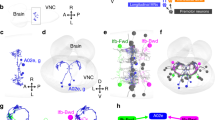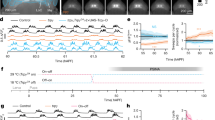Abstract
Locomotion depends on the integration of sensory information with the activity of central circuitry, which generates patterned discharges in motor nerves to appropriate muscles1,2. Isolated central networks generate fictive locomotor rhythms (recorded in the absence of movement), indicating that the fundamental pattern of motor output depends on the intrinsic connectivity and electrical properties of these central circuits3,4. Sensory inputs are required to modify the pattern of motor activity in response to the actual circumstances of real movement. A central issue for our understanding of how locomotor circuits are specified and assembled is the extent to which sensory inputs are required as such systems develop5. Here we describe the effects of eliminating sensory function and structure on the development of the peristaltic motor pattern of Drosophila embryos and larvae. We infer that the circuitry for peristaltic crawling develops in the complete absence of sensory input; however, the integration of this circuitry into actual patterns of locomotion requires additional information from the sensory system. In the absence of sensory inputs, the polarity of movement is deranged, and backward peristaltic waves predominate at the expense of forward peristalsis.
This is a preview of subscription content, access via your institution
Access options
Subscribe to this journal
Receive 51 print issues and online access
$199.00 per year
only $3.90 per issue
Buy this article
- Purchase on Springer Link
- Instant access to full article PDF
Prices may be subject to local taxes which are calculated during checkout





Similar content being viewed by others
References
Dickinson, M. H. et al. How animals move: an integrative view. Science 288, 100–106 (2000).
Pearson, K. G. Proprioceptive regulation of locomotion. Curr. Opin. Neurobiol. 5, 786–791 (1995).
Marder, E. & Calabrese, R. L. Principles of rhythmic motor pattern generation. Physiol. Rev. 76, 687–717 (1996).
Grillner, S. Neurobiological bases of rhythmic motor acts in vertebrates. Science 228, 143–149 (1985).
Sanes, D. H., Reh, T. A. & Harris, W. A. Development of the Nervous System (Academic, San Diego, 2000).
Berrigan, D. & Pepin, D. J. How maggots move: allometry and kinematics of crawling in larval diptera. J. Insect Physiol. 41, 329–337 (1995).
Kernan, M., Cowan, D. & Zucker, C. Genetic dissection of mechanosensory transduction: mechanoreception-defective mutations of Drosophila. Neuron 12, 1195–1206 (1994).
Kaliss, N. The effect on development of a lethal deficiency in Drosophila melanogaster: with a description of the normal embryo at the time of hatching. Genetics 24, 244–270 (1939).
Siekhaus, D. E. & Fuller, R. S. A role for amontillado, the Drosophila homolog of the neuropeptide precursor processing protease PC2, in triggering hatching behaviour. J. Neurosci. 10, 6942–6954 (1999).
Brand, A. H. & Perrimon, N. Targeted gene expression as a means of altering cell fates and generating dominant phenotypes. Development 118, 401–415 (1993).
Hummel, T., Krukkert, K., Roos, J., Davis, G. & Klämbt, C. Drosophila Futsch/22C10 is a MAP1B-like protein required for dendritic and axonal development. Neuron 26, 357–370 (2000).
Sweeney, S. T., Broadie, K., Keane, J., Niemann, H. & O'Kane, C. J. Targeted expression of tetanus toxin light chain in Drosophila specifically eliminates synaptic transmission and causes behavioural deficits. Neuron 14, 341–351 (1995).
Jan, Y. N. & Jan, L. Y. in The Development of Drosophila melanogaster (eds Bate, M. & Martinez-Arias, A) 1207–1244 (Cold Spring Harbor Laboratory Press, New York, 1993).
Huang, Z. & Kunes, S. Hedgehog, transmitted along retinal axons, triggers neurogenesis in the developing visual centers of the Drosophila brain. Cell 86, 411–422 (1996).
Schneiderman, A. M., Hildebrand, J. G., Brennan, M. M. & Tumlinson, J. H. Trans-sexually grafted antennae alter pheromone-directed behaviour in a moth. Nature 323, 801–803 (1986).
Nolo, R., Abbot, L. A. & Bellen, H. J. Senseless, a Zn finger transcription factor, is necessary and sufficient for sensory organ development in Drosophila. Cell 102, 349–362 (2000).
Marder, E. Motor pattern generation. Curr. Opin. Neurobiol. 10, 691–698 (2000).
Richards, K. S. & Marder, E. The actions of crustacean cardioactive peptide on adult and developing stomatogastric ganglion motor patterns. J. Neurobiol. 44, 31–44 (2000).
Boothby, K. M. & Roberts, A. The stopping response of Xenopus laevis embryos: behaviour, development and physiology. J. Comp. Physiol. 170, 171–180 (1992).
Haverkamp, L. J. & Oppenheim, R. W. Behavioural development in the absence of neural activity: effects of chronic immobilization on amphibian embryos. J. Neurosci. 6, 1332–1337 (1986).
Hamburger, V. & Oppenheim, R. Prehatching motility and hatching behavior in the chick. J. Exp. Zool. 166, 171–203 (1967).
van Mier, P., Armstrong, J. & Roberts, A. Development of early swimming in Xenopus laevis embryos: myotomal musculature, its innervation and activation. Neuroscience 32, 113–126 (1989).
Reynolds, S. A., French, K. A., Baader, A. & Kristan, W. B. Jr Development of spontaneous and evoked behaviors in the medicinal leech. J. Comp. Neurol. 402, 168–180 (1998).
Katz, L. C. & Shatz, C. J. Synaptic activity and the construction of cortical circuits. Science 274, 1133–1138 (1996).
Turrigiano, G. G. Homeostatic plasticity in neuronal networks: the more things change, the more they stay the same. Trends Neurosci. 22, 221–227 (1999).
Baines, R. A., Uhler, J. P., Thompson, A., Sweeney, S. T. & Bate, M. Altered electrical properties in Drosophila neurons developing without synaptic transmission. J. Neurosci. 21, 1523–1531 (2001).
Lin, D. M. & Goodman, C. S. Ectopic and increased expression of Fasciclin II alters motorneuron growth cone guidance. Neuron 13, 507–523 (1994).
Luo, L., Liao, Y. J., Jan, L. Y. & Jan, Y. N. Distinct morphogenetic functions of similar small GTPases: Drosophila Drac1 is involved in axonal outgrowth and myoblast fusion. Genes Dev. 8, 1787–1802 (1994).
Hildago, A., Urban, J. & Brand, A. H. Targeted ablation of glia disrupts axon tract formation in the Drosophila CNS. Development 121, 3703–3712 (1995).
Wang, J. W. et al. Morphometric description of the wandering behaviour in Drosophila larvae: aberrant locomotion in Na and K channel mutants revealed by computer-assisted motion analysis. J. Neurogenet. 11, 231–254 (1997).
Acknowledgements
We thank our colleagues in Cambridge and Toronto for comments on this work, and M. Sokolowski for providing support during its completion. M.L.S was funded by a Luis Velez Scholarship from the Venezuelan National Academy of Sciences at Clare College, Cambridge. M.B. is a Royal Society Research Professor. This work was supported by a grant from the Wellcome Trust.
Author information
Authors and Affiliations
Corresponding author
Ethics declarations
Competing interests
The authors declare no competing financial interests.
Rights and permissions
About this article
Cite this article
Suster, M., Bate, M. Embryonic assembly of a central pattern generator without sensory input. Nature 416, 174–178 (2002). https://doi.org/10.1038/416174a
Received:
Accepted:
Issue Date:
DOI: https://doi.org/10.1038/416174a
This article is cited by
-
Puckered and JNK signaling in pioneer neurons coordinates the motor activity of the Drosophila embryo
Nature Communications (2023)
-
Neural circuits driving larval locomotion in Drosophila
Neural Development (2018)
-
Data-driven analysis of motor activity implicates 5-HT2A neurons in backward locomotion of larval Drosophila
Scientific Reports (2018)
-
The Hunchback temporal transcription factor establishes, but is not required to maintain, early-born neuronal identity
Neural Development (2017)
-
Whole-central nervous system functional imaging in larval Drosophila
Nature Communications (2015)
Comments
By submitting a comment you agree to abide by our Terms and Community Guidelines. If you find something abusive or that does not comply with our terms or guidelines please flag it as inappropriate.



